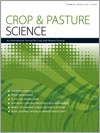This study applied newly developed Diversity Arrays Technology (DArT) and soybean and mungbean DArT libraries for quantitative trait locus (QTL) linkage analysis in recombinant inbred lines (RILs) from three soybean crosses that had previously been assessed for physiological response to severe drought stress. The phenotypic assessments had identified statistically significant genetic variation among and within the RIL populations and their parents for three drought-related responses: epidermal conductance (ge) and relative water content (RWC) during stress, and plant recovery after stress. The new linkage maps containing only DArT markers for the three populations individually contained 196–409 markers and 15–22 linkage groups (LGs), with an aggregate length ranging from 409.4 to 516.7 cM. An integrated map constructed by using the marker data from all three RIL populations comprised 759 DArT markers, 27 LGs and an expanded length of 762.2 cM. Two populations with the landrace accession G2120 as a parent, CPI 26671 × G2120 (CG) and Valder × G2120 (VG), respectively contained 106 and 34 QTLs. In each of these populations, 10 LGs harboured QTLs associated with RWC, ge and recovery ability, of which six similar LGs were associated with drought tolerance. A BLAST (Basic Local Alignment Search Tool) search for sequences of 19 selected DArT markers linked to QTLs conditioning the drought-response traits indicated that 18 DArT markers were unique and aligned to 12 soybean chromosomes. Comparison of these sequenced DArT markers with other markers associated with drought-related QTLs in previously reported studies using other marker types confirmed that five of them overlapped, whereas the remaining 13 were new. Except for chromosome 15, the chromosomes with which the DArT QTLs in the CG and VG populations were associated were those that had been shown to harbour drought-related QTLs in previous studies. A BLASTx protein database search identified soPt-856602 as being associated with the gene for a probable glycosyltransferase At5g03795-like isoform X1 on chromosome 6. Although the several QTLs identified in the study were all of relatively minor effect, it was concluded that, because the DArT technology involves large numbers of markers and enables many lines to be genotyped simultaneously, it should help the process of manipulating multiple QTLs and so enhance their likely cumulative effect.
How to translate text using browser tools
31 July 2015
Use of DArT molecular markers for QTL analysis of drought-stress responses in soybean. II. Marker identification and QTL analyses
Hang T. T. Vu,
A. Kilian,
A. T. James,
L. M. Bielig,
R. J. Lawn
ACCESS THE FULL ARTICLE

Crop and Pasture Science
Vol. 66 • No. 8
July 2015
Vol. 66 • No. 8
July 2015
epidermal conductance
genotyping
leaf area maintenance
recovery
relative water content





